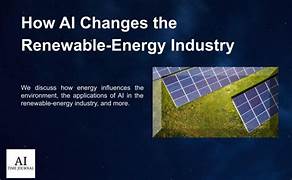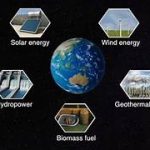Can Technological Advancements Lead to a Fully Renewable Energy-Dependent World?
As the global energy demand continues to rise, the need for sustainable energy solutions becomes increasingly urgent. Fossil fuels, the primary energy source for over a century, are a major contributor to climate change and environmental degradation. In response, renewable energy sources like solar, wind, hydroelectric, and geothermal power are rapidly gaining traction as cleaner, more sustainable alternatives. But can technological advancements truly lead to a world that is fully dependent on renewable energy?
This article explores the potential for a fully renewable energy-dependent world, examining the role of technological innovation, the challenges associated with energy storage and grid integration, and the broader societal and economic implications of transitioning to renewable energy.
The Current Energy Landscape: A Shift Toward Renewables
To understand the potential for a renewable energy-dependent world, it’s essential to first examine the current state of global energy production and consumption. As of today, fossil fuels still dominate the energy mix, providing around 80% of global energy needs. However, there has been a significant shift toward renewable energy in recent years, driven by concerns over climate change, energy security, and technological innovation.
Renewable energy sources accounted for nearly 29% of global electricity generation in 2021, with solar and wind playing the most prominent roles. In some regions, such as parts of Europe and the United States, renewable energy already outpaces fossil fuels in power generation. For example, in 2020, renewable energy surpassed coal as the dominant energy source in the U.S. for the first time. But the question remains: can this trend be scaled to provide 100% of global energy needs?
Technological Advancements Driving the Renewable Energy Revolution
Technological innovation is at the heart of the renewable energy transition. Over the past few decades, advancements in solar, wind, and energy storage technologies have made renewable energy more accessible, affordable, and efficient.
1. Solar Power: A Bright Future
Solar energy has seen dramatic cost reductions and efficiency improvements in recent years. The cost of solar panels has dropped by more than 80% since 2010, making solar energy an increasingly viable option for large-scale power generation and residential use. Innovations in photovoltaic (PV) technology, such as bifacial panels and perovskite solar cells, promise even higher efficiencies, further reducing costs and increasing energy production.
In addition, solar power is one of the most abundant sources of renewable energy. With the sun providing more energy to Earth in one hour than the entire world consumes in a year, solar has the potential to meet global energy needs. However, one of the key challenges for solar energy is its intermittent nature. The sun doesn’t always shine, which brings us to the next crucial innovation: energy storage.
2. Wind Power: Harnessing the Power of the Air
Wind energy is another key player in the renewable energy landscape. Like solar, wind power has seen significant technological advancements, particularly in turbine design. Modern wind turbines are much larger and more efficient than their predecessors, capable of generating more electricity with less environmental impact. Offshore wind farms, which take advantage of stronger and more consistent winds at sea, are also becoming a major area of focus.
The global capacity for wind energy has grown exponentially in recent years. According to the Global Wind Energy Council, global wind capacity reached 837 GW by the end of 2020, with more than 70 countries having installed wind power. Wind energy is particularly attractive for countries with abundant coastlines or open plains, such as the United States, China, and several European nations.
While wind energy is a powerful tool for renewable energy generation, its reliance on wind patterns introduces similar intermittency challenges to solar. As such, effective energy storage and grid integration are essential for maximizing the potential of wind power.
3. Energy Storage: Overcoming Intermittency
One of the most significant hurdles to a fully renewable energy-dependent world is the issue of intermittency. Solar and wind power are both variable energy sources—solar energy is only available when the sun shines, and wind energy is dependent on wind speeds. This intermittency means that a reliable energy storage solution is necessary to ensure a constant and stable energy supply.
Advancements in energy storage technologies, particularly batteries, have made significant strides in recent years. Lithium-ion batteries, which have become widely used in consumer electronics, electric vehicles, and grid storage, have seen improvements in both energy density and cost efficiency. Researchers are also exploring alternative battery technologies, such as solid-state batteries and flow batteries, which could offer even higher performance and longer lifespans.
In addition to batteries, other forms of energy storage, such as pumped hydro storage, compressed air energy storage, and thermal energy storage, are being developed to provide large-scale storage solutions. For example, pumped hydro storage uses excess renewable energy to pump water uphill, which is then released to generate electricity when demand is high. Similarly, thermal energy storage systems can store heat for later use, offering another potential solution for balancing renewable energy supply and demand.
4. Smart Grids and Distributed Energy Systems
To fully integrate renewable energy into the grid, advancements in grid technology are essential. Smart grids, which use digital communication and automation to manage electricity flow, allow for real-time monitoring and control of energy distribution. By optimizing energy use and accommodating renewable energy sources, smart grids can help ensure that excess energy from solar and wind is stored or redirected when needed.
Distributed energy systems, such as rooftop solar panels and home battery storage, are also playing a critical role in the renewable energy transition. These systems allow individuals and communities to generate, store, and consume their own electricity, reducing reliance on centralized power plants and increasing energy resilience.
By combining smart grids with renewable energy sources and storage solutions, we can create a more flexible, decentralized energy system that is capable of meeting the demands of a growing population while reducing carbon emissions.
Challenges and Barriers to a Fully Renewable Energy-Dependent World
While technological advancements are making renewable energy more feasible, several challenges must be addressed before we can transition to a fully renewable energy-dependent world.
1. Infrastructure Overhaul
One of the most significant barriers to a renewable energy future is the existing energy infrastructure. In many parts of the world, power grids were designed for centralized fossil fuel-based generation, not the decentralized, variable sources of renewable energy. Upgrading or replacing this infrastructure to accommodate renewable energy requires substantial investment and time.
For instance, transmission lines may need to be rebuilt or expanded to connect remote wind farms and solar plants to urban areas. In some regions, the grid capacity is simply not sufficient to handle the influx of renewable energy, particularly during peak production times. Additionally, energy storage solutions need to be scaled up to ensure that excess energy can be stored and accessed when needed.
2. Political and Economic Factors
The transition to renewable energy requires strong political will and long-term planning. Governments play a crucial role in incentivizing renewable energy development through subsidies, tax incentives, and regulations. However, political opposition from vested interests in the fossil fuel industry and concerns over job losses in traditional energy sectors can slow down the transition.
Economic factors also play a role. While renewable energy costs have fallen dramatically, the initial investment required for large-scale infrastructure, energy storage, and grid modernization can be prohibitively expensive for some countries, particularly in the developing world.
3. Energy Storage Limitations
While energy storage technology is advancing rapidly, it still faces limitations in terms of scalability, efficiency, and cost. Current battery technologies are not yet capable of storing the vast amounts of energy required to support a fully renewable world, particularly for regions with high energy demand. Additionally, the mining and production of materials for batteries can have environmental and ethical implications.
Conclusion: A Bright Future, but Challenges Remain
Technological advancements have made the dream of a renewable energy-dependent world more attainable than ever. Solar, wind, energy storage, and smart grid technologies have the potential to revolutionize the global energy landscape and reduce our dependence on fossil fuels. However, several challenges remain, including the need for infrastructure overhaul, political support, and continued innovation in energy storage solutions.
While the goal of a fully renewable energy-dependent world may take decades to achieve, the progress made thus far provides hope. As technological advancements continue to accelerate, and as nations and industries work together to overcome barriers, a sustainable, renewable energy future is not just possible—it is within our reach.


